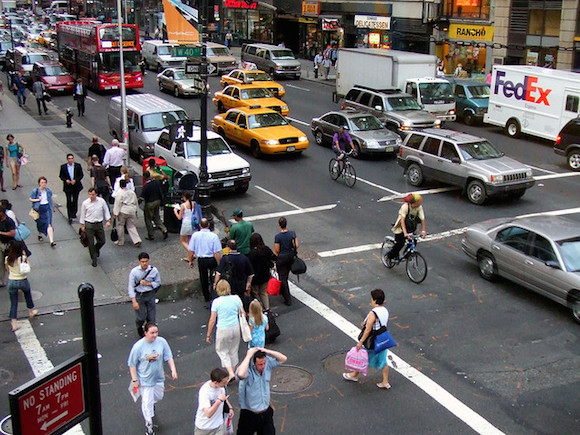
We give a lot of support to people who ride their bikes around here, but we don’t want to come off as being hostile the humble pedestrian. Walking, after all, is the ultimate broke form of transportation, more so than even a bike. If you’ve walked in New York for long enough, you’ve probably (hopefully) developed a form of ownership over our streets and sidewalks, as that attitude denoting that you’re in fact walking here is the best part of being a pedestrian around here. We wait for no car and no walk signal. In face, according to an anecdote in a Times Magazine story about how to make the intersection of Atlantic Avenue, Washington Avenue and Underhill Avenue safer, we step off the curb so quickly we’ve broken the usual metrics for timing crosswalk signals and possibly even time itself.
The Times Magazine looked at the general question of how to make cities safer for pedestrians by looking at one in particular that’s ludicrously dangerous, where Washington crosses Atlantic and splits off into Underhill. Buried in that interesting profile of the dangerous intersection is this nugget about someone from the Transportation Department studying how long it takes New Yorkers to step off the curb and start walking through the crosswalk once a walk signal flashes, which is known as pedestrian reaction time. The normal pedestrian reaction time around the country, from walk signal to stepping off the cub is is supposed to be three seconds, but in New York, well:
Peters, who studied crosswalks in only New York, found that that was six seconds too many — she found reaction times of negative three seconds. New Yorkers, whether they waited patiently on the sidewalk or had already maneuvered their way into the crosswalk, were moving before the walk signal even flashed…Peters, who presented her findings this year at a national conference, had a hard time persuading the audience, composed of transportation professionals from cities around the country, about the validity of her findings. “They were incredulous,” Russo said. “They were like, ‘There’s no such thing as a negative reaction time!’ ”
There’s obviously the hoary old cliche of “the New York minute” being faster than the usual 60 seconds. What hadn’t been considered, until this news anyway, was that the New York minute was more of a breakthrough in physics than a metaphor. A New York minute, driven by the speed and impatience of our pedestrians, is more of a theoretical construct than we ever knew, lapping time itself and putting us somehow ahead of where we were supposed to be behind.
Every time you peer into the street and decide to just go, you’re reacting so quickly you may as well be traveling through time. So maybe that constant hum, that energy that people are always prescribing to New York is actually a literal hum, a buzzing that you can almost feel, built up by our decades of traveling through time in tiny bursts, from refusing to wait for the damn walk signal.
4 Comments
Leave a Reply




Or, you know, we’re keeping an eye on the traffic light and start walking once it turns yellow.
I like my explanation better
But if we move faster than light then the other side of the road will age faster than we do, meaning we’ll miss our appointments by at least 80 years!
Hahaha, this is awesome. Other people don’t do this?